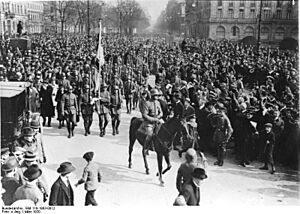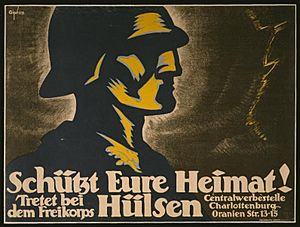Freikorps facts for kids
The word Freikorps comes from German and means "Free Corps." It was first used for groups of volunteer soldiers in Germany. After World War I, the term changed. It then described special paramilitary units. These units became well-known during the Weimar Republic. They often fought against Communism in different German towns.
Contents
Early Freikorps Groups
The very first Freikorps groups appeared in the 18th century. Frederick II of Prussia started them during the Seven Years' War. Later, during the Napoleonic Wars, other Freikorps were formed. Leaders like Ferdinand von Schill and Ludwig Adolf Wilhelm von Lützow commanded them.
Regular armies often did not fully trust these early Freikorps. They were mostly used for guarding duties. They also handled smaller tasks that regular soldiers did not do.
Freikorps After World War I
The meaning of "Freikorps" changed a lot after 1918. After Germany lost World War I, many soldiers returned home. They formed new paramilitary groups. These groups were called Freikorps. They became the main unofficial military groups of that time.
Many returning soldiers found it hard to go back to normal life. Joining a Freikorps gave them a military structure again. Others were angry about losing the war. They joined to fight against Communism or to get revenge.
The Minister of Defence, Gustav Noske, supported these groups. He was a member of the Social Democratic Party of Germany. Noske used the Freikorps to stop the German Revolution of 1918-19. They also helped defeat the Marxist Spartacus League. The Freikorps were involved in the deaths of Karl Liebknecht and Rosa Luxemburg in January 1919. They also helped defeat the Bavarian Soviet Republic in 1919.
In 1920, Adolf Hitler began his political work. He led a small group called the German Workers Party. This party soon became the Nazi Party. Many future Nazi Party members had been in the Freikorps. These included Ernst Röhm, who would lead the Sturmabteilung (SA). Another was Rudolf Höss, who later became the commander of the Auschwitz concentration camp.
Not all Freikorps leaders supported Hitler. Hermann Ehrhardt led the Marinebrigade Ehrhardt. He and his deputy, Eberhard Kautter, refused to help Hitler. They also did not help Erich Ludendorff in the Beer Hall Putsch.
Hitler and the Freikorps
On November 9, 1933, Freikorps leaders gave their old battle flags to Hitler's SA and SS. This happened in a large ceremony. However, Hitler had many problems with the Freikorps.
Many former Freikorps members joined the SA. During the Night of the Long Knives, many of them were arrested or killed. This included Ehrhardt and Röhm. In a speech to the Reichstag in July 1934, Hitler even called the Freikorps "enemies of Germany."
In 1939, during the Polish September Campaign, a new group formed. It was called Freikorps Ebbinghaus. This group was meant to work behind the main battle lines. However, it did not perform well. It was then sent to fight as a regular army unit. It still did not do well and was ended in less than a year.
Famous Freikorps Members
|
|
|
Famous Freikorps Units
- Volunteer Division of Horse Guards (Garde-Kavallerie-Schützendivision)
- This unit was involved in the deaths of Rosa Luxemburg and Karl Liebknecht in 1919.
- It was commanded by Captain Pabst.
- Defence Minister Gustav Noske ordered it to be disbanded in July 1919.
- Freikorps Maercker (Maercker's Volunteer Rifles)
- Reinhard Heydrich was a member of this unit.
- It was started by Ludwig Maercker.
- Freikorps Roßbach (Rossbach)
- This unit was started by Gerhard Roßbach.
- It rescued the Iron Division after a very long march.
- Marinebrigade Ehrhardt (The Second Naval Brigade)
- This unit took part in the Kapp Putsch of 1920.
- After it was disbanded, some members started the Organisation Consul. This group was involved in many political killings.
- Iron Division (Eiserne Division)
- This unit fought in the Baltic.
- It was trapped in Thorensberg by the Latvian Army. The Rossbach Freikorps rescued it.
- Freikorps Ebbinghaus
- Freikorps Oberland
- Eiserne Brigade (Iron Brigade, later Iron Division)
- Freikorps Epp
- Hamburg Free Corps
- Lowenfeld Brigade (First Naval Brigade)
- Potsdam Free Corps
- Freikorps Lützow
Related pages
- Freikorps in the Baltic
- Waite, Robert G L. Vanguard of Nazism, 1969, W W Norton & Co
Images for kids
-
Armed Freikorps paramilitaries in Berlin in 1919.
-
Minister of the Reichswehr, Gustav Noske, visits the Freikorps Hülsen in Berlin in January 1919.
See also
 In Spanish: Freikorps para niños
In Spanish: Freikorps para niños








